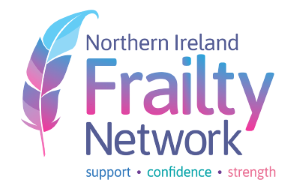What is Frailty?
Frailty is defined by the World Health Organisation as “a progressive age-related decline in physiological systems that results in decreased reserves of intrinsic capacity which confers extreme vulnerability to stressors and increases the risk of adverse health outcomes”. With frailty, even minor events can trigger disproportionate changes in health status after which the patient fails to recover to their previous level of health. Frailty is a spectrum disorder which ranges from mild to severe frailty.
Frailty is not an inevitable part of ageing; it is a long term condition (LTC) in the same sense that Diabetes or Alzheimer’s disease are. It varies in severity (individuals should not be labelled as being frail or not frail but simply that they have frailty). The frailty state for an individual is not static; it can be made better and worse.
The prevalence of frailty among people aged 60+ in Northern Ireland is estimated at 21%, with rates rising with age. In NI 16% of people aged 60-64 are likely to be living with frailty, rising to 36% in those aged 80+ (Frailty and Disability, Research Brief, CARDI, 2014).
aged 60+ in Northern Ireland is estimated at 21%, with rates rising with age. In NI 16% of people aged 60-64 are likely to be living with frailty, rising to 36% in those aged 80+ (Frailty and Disability, Research Brief, CARDI, 2014).
People living with frailty have a substantially increased risk of falls, disability, long-term care and death, yet many of these individuals are unaware that they are living with the condition.
With proper identification and appropriate active management of older people living with frailty, health and social care crisis can be reduced and detrimental impacts diminished through holistic health and social care provision.
There are 5 recognised frailty syndromes. The presence of one or more of these could indicate that the individual has frailty:
- Falls
- Immobility – sudden change, ‘gone off feet’
- Delirium – acute confusion or sudden worsening of confusion in someone with previous dementia or known memory loss
- Incontinence – new onset or worsening or urinary or faecal incontinence
- Susceptibility to side effects of medication
In additional to these syndromes, in Northern Ireland, experts would also argue that social isolation and poor nutrition are also factors which could indicate the presence of frailty.
The Public Health Agency (PHA), vision is that “All people and communities are enabled and supported in achieving their full health and wellbeing potential, and inequalities in health are reduced.” In working to fulfil this vision, one of the five overarching outcomes, identified in the PHA Corporate Plan 2017 – 21 is that:
‘All older adults are enabled to live healthier and more fulfilling lives’
